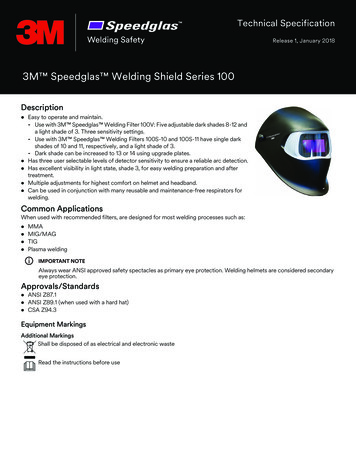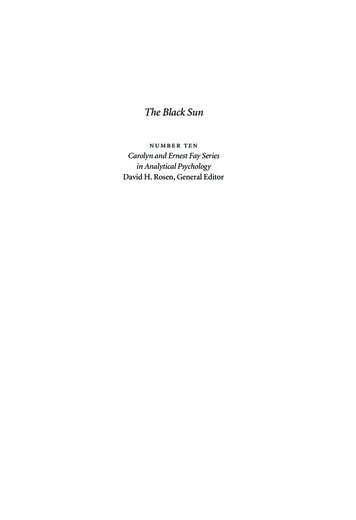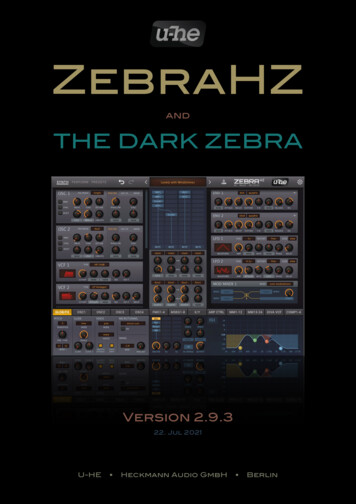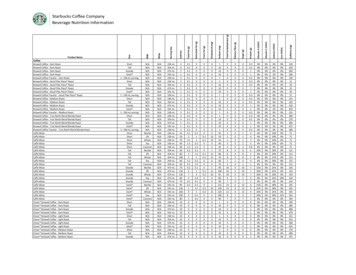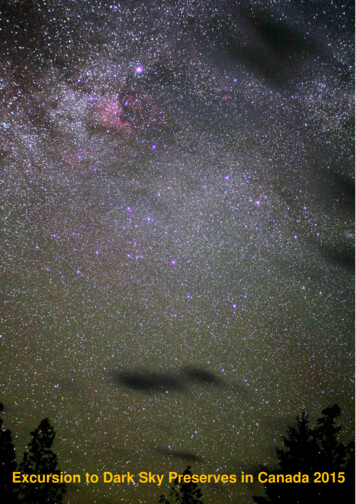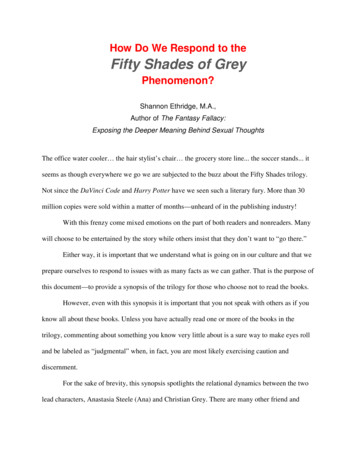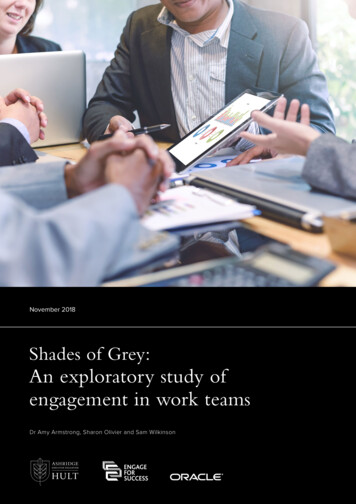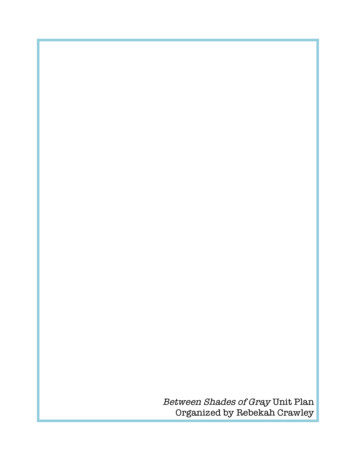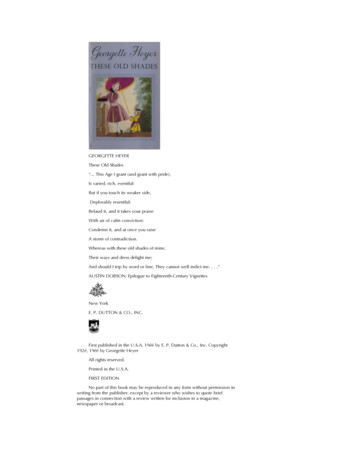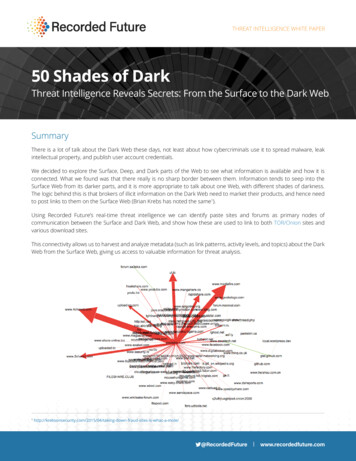
Transcription
THREAT INTELLIGENCE WHITE PAPER50 Shades of DarkThreat Intelligence Reveals Secrets: From the Surface to the Dark WebSummaryThere is a lot of talk about the Dark Web these days, not least about how cybercriminals use it to spread malware, leakintellectual property, and publish user account credentials.We decided to explore the Surface, Deep, and Dark parts of the Web to see what information is available and how it isconnected. What we found was that there really is no sharp border between them. Information tends to seep into theSurface Web from its darker parts, and it is more appropriate to talk about one Web, with different shades of darkness.The logic behind this is that brokers of illicit information on the Dark Web need to market their products, and hence needto post links to them on the Surface Web (Brian Krebs has noted the same1).Using Recorded Future’s real-time threat intelligence we can identify paste sites and forums as primary nodes ofcommunication between the Surface and Dark Web, and show how these are used to link to both TOR/Onion sites andvarious download sites.This connectivity allows us to harvest and analyze metadata (such as link patterns, activity levels, and topics) about the DarkWeb from the Surface Web, giving us access to valuable information for threat ww.recordedfuture.com
50 Shades of Dark: How the Surface Web Reveals What’s Happening on the Dark WebIntroductionPeople talk about the Dark Web as a mysterious place, hard to find and inaccessible to normal Internet users. In thispaper we argue that there is no sharp border between the Surface Web and the Dark Web, and that there are indeedlinks from the former to the latter. Different parts of the Web thus exhibit varying degrees of shadiness, and can even becharacterized by both actual content and what it links to. Conceptually, we might distinguish three levels of the Web, eachportraying different characteristics:›› Surface Web»» Freely accessible»» Indexed by Google, Bing, and others»» Mostly open, but sometimes behind pay walls»» Fairly stable, content is available from source for a long time»» Language (mostly) suited for traditional Natural Language Processing (NLP), and tools exist for extracting and analyzing data›› Deep Web»» Often behind logins, but accessible to anyone registering»» Database driven, and therefore not indexed by search engines»» Sometimes by invitation only»» Mostly un-indexed by search engines such as Google and Bing›› Dark Web»» Not indexed or searchable by Google, Bing etc.»» Often on other networks such as TOR2, Freenet3, I2P4, etc.»» Frequently behind logins, accessible by invitation only»» Sometimes uses special language like slang, leetspeak etc. which is not easily analyzed by normal NLP tools.»» Volatile, with content that sometimes only stays available for a few minutes (in one study we did more than 10% of Pastebin postswere removed within 48 hours)Information tends to seep out even from the darkest corners of the Web, if for no other reason than because thatinformation has a value, which cannot be realized unless it is possible to find. Therefore it has to be marketed in some way.Wikipedia lists three uses of the Dark Web5 (or Darknet):1. Out of privacy concerns or for fear by dissidents of political reprisal2. To publish for criminal gain3. To share media files (sometimes copyrighted files)Clearly, our argument that information needs to be made accessible outside of the Dark Web to realize its (monetary)value holds for both (2) and (3) in this list. The Surface and Deep Web contain links to the Dark Web. How frequent is /en.wikipedia.org/wiki/Darknet (overlay network)23Recorded Future White Paper2
50 Shades of Dark: How the Surface Web Reveals What’s Happening on the Dark WebThe Data SetRecorded Future analyses more than 650,000 sources, ranging fromgovernment websites and big media to blogs, forums, paste sites,and social media. The Recorded Future index goes back more thansix years in time, and has analyzed more than 8.3 billion referencesto facts, each an individual mention of an event in a document. Ofthese 8.3 billion references, more than 700 million come from pastesites (such as Pastebin, Slexy, CopyTaste), one of the source types weidentify as bridging the Surface and Dark parts of the Web. RecordedFuture’s index contains 5 million references to malware, over 10 millionreferences to IP addresses, over 11 million references to hashes, and8.2 million references to cyber attack events. This is the wealth of dataon which we base our threat intelligence analyses in this report.A Journey to the Dark SideWhat does the linkage into the Dark Web look like, in reality? Weused the Recorded Future index to investigate this. Recorded Futurecollects and analyzes Surface Web sources, and its index also containsdata from forums, blogs, social media, and paste sites that we expectto contain both suspect or threat related content and links to otherparts of the Internet (e.g., TOR sites).As an initial example, we used the TOR Uncensored Hidden Wiki index Page) to manually locate a dubious reseller of credit cards (Premium Cards, http://slwc4j5wkn3yyo5j.onion/ ):Recorded Future White Paper3
50 Shades of Dark: How the Surface Web Reveals What’s Happening on the Dark WebWe then queried the Recorded Future index for the Onion link to Premium Cards, and indeed found 14 references fromthe last 3.5 months:These references all come from Pastebin. One of the pastes, for example, provides an index to several useful “FinancialMarketplaces”:Recorded Future White Paper4
50 Shades of Dark: How the Surface Web Reveals What’s Happening on the Dark WebAs a second example, we investigated if illicit material was being marketed in sources that Recorded Future does harvest.Credit card information with CVVs is a good example of such material, and we focused on material published in 2015, andonly in Russian. This yielded a small but interesting set of references related to advertising content and advice on how toobtain and use the stolen credit card information:Being even more specific, we looked for CVVs of credit cards related to Israel:Recorded Future White Paper5
50 Shades of Dark: How the Surface Web Reveals What’s Happening on the Dark WebThus, there is no doubt illicit material is being marketed not only on the Dark Web but also on other channels such as pastesites and forums.Some of this content is nefarious enough to get quickly removed, even from Pastebin:Recorded Future White Paper6
50 Shades of Dark: How the Surface Web Reveals What’s Happening on the Dark WebIn these cases, it is convenient that Recorded Future provides cached access to paste content we have harvested (NOTE:this feature is available only to registered Recorded Future clients):Links From the Surface to the Dark WebInspired by the discoveries above, we investigated the linkage from Twitter and Pastebin to TOR/Onion links. It turns outto be fairly low volume: out of 509 million tweets, about 65 million had cyber related content published in Q1 20156 therewere 37 million URLs, but only 499 of those were Onion links. As another example, of 6.7 million Pastebin documentsfrom 2015 Q1, with 226 million references in total, there were 8,316 Onion links, but only 1,036 unique links (the links withthe most references were to index pages, adult comics, and sellers of cannabis, passports, and ID cards). In general, thenumber of links to TOR was low in volume, but some of them were high value.The Malware MarketplaceWe have shown how stolen financial credentials are marketed, but what about tools used by cyber criminals – can thosealso be found in this borderland?In some cases the answer is a straightforward “yes.” To download a Remote Access Trojan (RAT) like DarkComet, justGoogle for instructions and download sites:6These are not all cyber related tweets for that time period, but a subset selected by Recorded Future filters.Recorded Future White Paper7
50 Shades of Dark: How the Surface Web Reveals What’s Happening on the Dark WebTo get a bigger picture of where DarkComet is being distributed and discussed, we extracted all links in documents relatedto it for a three-month period, using the Recorded Future API, and visualized the resulting links using the open sourcegraph visualization tool Gephi7:7http://gephi.github.io/Recorded Future White Paper8
50 Shades of Dark: How the Surface Web Reveals What’s Happening on the Dark WebThis graph illustrates the different kind of sites where malware is mentioned or found:›› General discussion forums (marked by yellow in the graph), including Facebook, Reddit, Twitter, and YouTube. Here, general discussionsabout a malware take place, and a lot of the traffic is related to security companies and general warnings about a new threat.›› More specialized forums, where hackers ask questions about how to find, download, modify, and use a malware. The Aljyyosh.comsite is a good example of such a site.›› Repositories where malware can be found and downloaded. These are marked by red ovals and include download and contentdistribution sites such as Dropbox, ge.tt, and Mediafire.Social media sites and forums thus act as the marketing channels for the download sites where malware and relatedservices can be found.Dark Marketing Trends?To see if sites like Pastebin can be an indicator of increased interest, and thus increased threat, from a specificMalware we looked at the total discussion around DarkComet vs. the discussion on Pastebin for nine months beginning onJuly 1st 2014; the chart below breaks up the total count into different media types (all data extracted using the RecordedFuture API):Recorded Future White Paper9
50 Shades of Dark: How the Surface Web Reveals What’s Happening on the Dark WebDuring 2014, the discussion was mostly active on sites related to cyber vulnerability conversations. In January 2015 thediscussion shifted over to social and mainstream media, mostly due to the discussions around the use of this Malwarein connection to the Charlie Hebdo events. There was actually an increase in mentions of DarkComet on Pastebin in lateNovember and December 2014. They are small in number, but the mentions which do exist are very instructive, as thefollowing screenshot illustrates:Recorded Future White Paper10
50 Shades of Dark: How the Surface Web Reveals What’s Happening on the Dark WebHere are a few of the sites linked to from Pastebin - note that these are instructions for how to download and set upDarkComet:Recorded Future White Paper11
50 Shades of Dark: How the Surface Web Reveals What’s Happening on the Dark WebIn addition to showing increased interest in DarkComet, the growing amount of mentions also indicates usage migratingfrom higher risk threat actors to “garden variety” threat actors who source their malware tools from Pastebin.Link PatternsNext, we examined all links from texts on paste sites and forums for a period of 3.5 months that contained a reference tomalware and had a link to some other site, which we evaluated to see where the link was directed. Below are the top linktargets. If we compare this list with a list of popular file sharing sites for general content, such as tes, we see a mix of “general” file sharing sites and some clearly more focussed on shady material.We also note that some very popular file sharing sites, like Dropbox, are missing from the top link list.Destination m163www.exploit4arab.net157Recorded Future White PaperPosition On Top List1412
50 Shades of Dark: How the Surface Web Reveals What’s Happening on the Dark .voxility.com117As seen, again a majority of the link destinations are file sharing sites of different kinds, showing that discussions aroundmalware on these sites tend to be accompanied with links where other content can be downloaded. This graph illustratesthe link pattern, and Pastebin is the main source of links:Recorded Future White Paper13
50 Shades of Dark: How the Surface Web Reveals What’s Happening on the Dark WebConclusionsThere are clear borders between the Surface, Deep, and Dark Web in terms of accessibility and tools, but there existsinformation on the Surface Web and on the Deep Web that can be used to gain important understanding of what ishappening on the Dark Web. Simple marketing mechanics underlies this – when something needs to be sold, prospectivecustomers need to be able to find information about it quickly. The available information includes topics, link patterns, andactivity levels.As illustrated by the study of mentions of the DarkComet malware, sites such as Pastebin act as a marketing channel byproviding a fairly unregulated place for posting both instructions and links to download sites for malware. Using a threatintelligence platform to monitor the activity on paste sites can therefore be a good way to get early warning signals forincreased use of certain kind of malware and stolen data or credentials.Topics also tend to migrate over time, from Dark to Surface Web, and analyzing these patterns allows us to understandwhen high end malware tools are becoming commodity malware. Such a shift means the volume of attacks using thecommodity malware will increase, but the average skill level of attackers will go down - and the highly skilled attackers willhave moved on to using another tool.About Recorded FutureWe arm you with real-time threat intelligence so you can proactively defend your organization against cyber attacks. With billionsof indexed facts, and more added every day, our patented Web Intelligence Engine continuously analyzes the entire Web to giveyou unmatched insight into emerging threats. Recorded Future helps protect four of the top five companies in the world.Recorded Future, 363 Highland Avenue, Somerville, MA 02144 USA Recorded Future, Inc. All rights reserved. All trademarks remain property of their respective owners. 06/15REQUEST A DEMO@RecordedFuturewww.recordedfuture.com
Surface Web from its darker parts, and it is more appropriate to talk about one Web, with different shades of darkness. . 50 Shades of Dark Threat Intelligence Reveals Secrets: From the Surface to the Dark Web . To download a Remote Access Trojan (RAT) like DarkComet, just Goo
